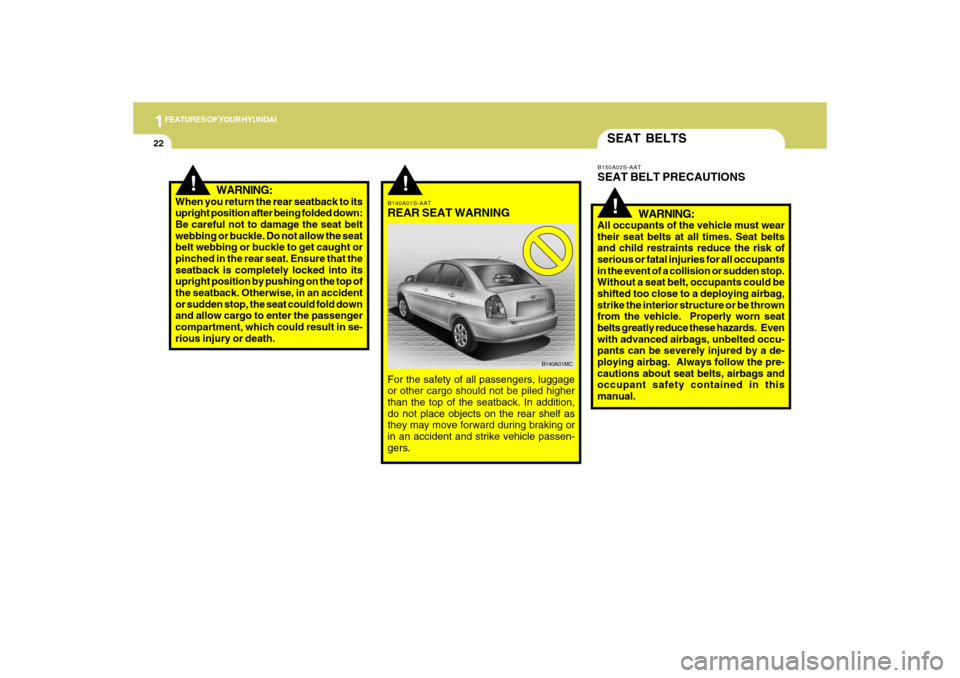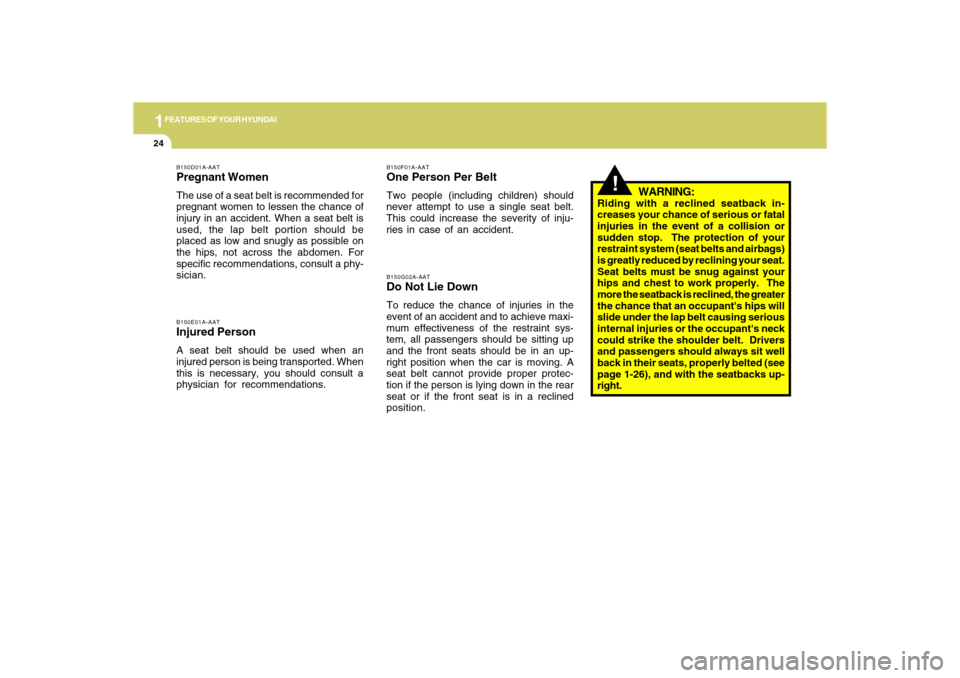2009 Hyundai Accent airbag
[x] Cancel search: airbagPage 4 of 266

F4
A110A01A-AAT
VEHICLE DATA COLLECTION AND EVENT DATA RECORDERS
Your Hyundai vehicle is equipped with many high technology, electronically controlled systems
that help to ensure your vehicle operates properly and provides the performance that you
expect. These systems utilize computers to monitor the operation of various systems and
components and help to control their operation. These computerized system operations are
wide-ranging and involve components to reduce emissions, to continuously evaluate the
readiness of the airbag and seat belt pretensioner systems, to determine when the airbag and
seat belt pre-tensioner systems should be deployed and then to activate the deployment, and
if equipped, to operate anti-lock braking, traction control and electronic stability control to assist
the driver to control the vehicle in difficult driving situations. These systems electronically store
information that is useful to service technicians when they need to diagnose and repair these
systems. Additional information is stored only when a crash occurs that results in the
deployment of the airbags or seat belt pre-tensioners. This type of data storage is done by
devices called event data recorders(EDR).
After a crash event, the airbag and seat belt pre-tensioner computer system, known as the
Supplemental Restraint System Control Module (SRSCM) or Airbag Control Unit (ACU), may
record some information about the condition of the vehicle and how it was being operated. This
information consists of data related to seat belt usage and if there was diagnostic information
in the airbag or seat belt systems at the time that a crash occurred, and if the ACU sensed that
a crash of sufficient severity occurred to require seat belt pre-tensioner or airbag deployment.
To retrieve this information, special equipment is needed and access to the vehicle or the device
that stores the data is required. Hyundai will not access information about a crash event or share
it with others except:
o in response to an official request of police or similar government office, or
o with the consent of the vehicle owner or, if the vehicle is leased, with the consent of the lessee,
or
o as part of Hyundai’s defense of litigation, or
o as required by law.
Page 9 of 266

F9
1. Hood Release Lever ...................................................1-93
2. Front Fog Light Switch (If Installed) ............................1-82
3. Panel Brightness Control Knob (Rheostat Switch) ....1-80
4. Instrument Cluster .......................................................1-60
5. Multi-Function Light Switch .........................................1-76
6. Cruise Control (If Installed) .......................................1-101
7. Horn and Driver's Front Airbag ........................ 1-101, 1-42
8. Windshield Wiper/Washer Switch ..............................1-78
9. Hazard Warning Light Switch .....................................1-81
10. Digital Clock ................................................................1-82
11. "PASSENGER AIR BAG OFF" Indicator .....................1-49
12. Rear Window Defroster Switch ...................................1-81
13. Audio System (If Installed) ........................................1-12014. Passenger's Front Airbag ...........................................1-42
15. Glove Box ....................................................................1-88
16. Heating/Air Conditioning Control Panel (If Installed)1-107
17. Multi Box .....................................................................1-89
18. Cigarette Lighter .........................................................1-82
19. AUX Outlet ................................................................1-105
20. Power Outlet ...............................................................1-83
21. Ashtray........................................................................1-83
22. Shift Lever ..................................................................... 2-9
23. Parking Brake Lever ...................................................1-91
24. Front Drink Holder ......................................................1-84
25. Trunk Lid Release Lever (If Installed) ........................1-97
26. Fuel Filler Lid Release Lever .....................................1-94
CAUTION:
When installing a container of liquid air freshener inside the vehicle, do not place it near the instrument cluster
nor on the instrument panel surface. If there is any leakage from the air freshener onto these areas
(Instrument cluster, instrument panel or air ventilator), it may damage these parts. If the liquid from the air
freshener does leak onto these areas, wash them with water immediately.
!
Page 10 of 266

YOUR VEHICLE AT A GLANCE
F10
High Beam Indicator Light
Parking Brake/Low Brake Fluid Level
Warning Light
Door Ajar Warning Light and Chime O/D OFF Indicator
(Automatic transaxle only)
B255A03MC-AATINDICATOR SYMBOLS ON THE INSTRUMENT PANEL
* More detailed explanations of these items will be found begining
on page 1-64.
SRS (Airbag) Warning Light
ABS Service Reminder Indicator (If Installed)
Turn Signal Indicator Lights
Low Oil Pressure Warning Light
Charging System Warning LightLow Fuel Level Warning Light
Malfunction Indicator Light
Seat Belt Warning Light and Chime
Trunk Lid / Tail Gate Open Warning Light
Check Fuel Filler Cap Warning LightEngine Coolant Temperature Warning LightLow Tire Pressure Telltale (If Installed)TPMS (Tire Pressure Monitoring System) Malfunction
Indicator (If Installed)Cruise Indicator Light (If Installed)Cruise SET Indicator Light (If Installed)
Page 11 of 266

FEATURES OF YOUR HYUNDAI
1
Fuel Recommendations ................................................ 1-2
Breaking in Your New Hyundai .................................... 1-3
Keys.............................................................................. 1-4
Door Locks ................................................................... 1-4
Theft-Alarm System ...................................................... 1-8
Window Glass ............................................................1-11
Seats...........................................................................1-13
Seat Belts...................................................................1-22
Child Restraint System...............................................1-31
Advanced Supplemental Restraint (AIRBAG)
System......................................................................1-41
Instrument Cluster and Indicator Lights .....................1-60
Warning and Indicator Lights ......................................1-64
Trip Computer.............................................................1-73
Multi-Function Light Switch .........................................1-76
Windshield Wiper and Washer Switch.......................1-78
Sunroof.......................................................................1-84
Mirror...........................................................................1-89
Hood Release.............................................................1-93
Cruise Control System.............................................1-101
Heating and Cooling Control.................................... 1-106
Stereo Sound System..............................................1-117
Antenna.....................................................................1-119
Audio System...........................................................1-120
1
Page 24 of 266

1FEATURES OF YOUR HYUNDAI14
To move the seat toward the front or rear,
pull the lock release lever upward. This
will release the seat on its track so you
can move it forward or rearward to the
desired position.
When you find the position you want,
release the lever and slide the seat for-
ward or rearward on its track until it locks
into the desired position and cannot be
moved further.
!
WARNING:
After adjusting the seat, always check
that it is securely locked into place by
attempting to move the seat forward or
rearward without using the lock release
lever. Sudden or unexpected move-
ment of the driver's seat could cause
you to lose control of the vehicle result-
ing in an accident.
B080B03A-AATFRONT SEATS
Adjusting Seat Forward and Rear-
ward
!
WARNING:
o Never adjust the driver’s seat while
the vehicle is moving. Any sudden
or unexpected movement of the seat
could cause you to lose control of
the vehicle resulting in an accident.
Only adjust the driver’s seat when
the vehicle is stationary.
o Do not sit or lean unnecessarily close
to the airbag. Position the seat so
that you can sit as far back as pos-
sible from the airbag and still com-
fortably reach all controls.B080A01FC-AATADJUSTABLE SEATS
OMC029026
Page 25 of 266

1
FEATURES OF YOUR HYUNDAI
151
FEATURES OF YOUR HYUNDAI
15
B080C02A-AATAdjusting Seatback AngleTo recline the seatback, lean forward to
take your weight off it, then pull up on the
recliner control lever at the outside edge
of the seat. Now lean back until the de-
sired seatback angle is achieved. To lock
the seatback into position, release the
recliner control lever.
!
WARNING:
Riding with a reclined seatback in-
creases your chance of serious or fatal
injuries in the event of a collision or
sudden stop. The protection of your
restraint system (seat belts and airbags)
is greatly reduced by reclining your seat.
Seat belts must be snug against your
hips and chest to work properly. The
more the seatback is reclined, the greater
the chance that an occupant's hips will
slide under the lap belt or the occupant's
neck will strike the shoulder belt. Driv-
ers and passengers should always sit
well back in their seats, properly belted,
and with the seatbacks upright.
OMC029027
C010104AMCHeadrestThe driver's and front passenger's seats
are equipped with a headrest for the
occupant's safety and comfort.
The headrest not only provides comfort
for the driver and front passenger, but
also helps to protect the head and neck
in the event of a collision.
OBH038075L
Page 32 of 266

1FEATURES OF YOUR HYUNDAI22
SEAT BELTS
B140A01S-AATREAR SEAT WARNINGFor the safety of all passengers, luggage
or other cargo should not be piled higher
than the top of the seatback. In addition,
do not place objects on the rear shelf as
they may move forward during braking or
in an accident and strike vehicle passen-
gers.
B140A01MC
!
!
B150A02S-AATSEAT BELT PRECAUTIONS
WARNING:All occupants of the vehicle must wear
their seat belts at all times. Seat belts
and child restraints reduce the risk of
serious or fatal injuries for all occupants
in the event of a collision or sudden stop.
Without a seat belt, occupants could be
shifted too close to a deploying airbag,
strike the interior structure or be thrown
from the vehicle. Properly worn seat
belts greatly reduce these hazards. Even
with advanced airbags, unbelted occu-
pants can be severely injured by a de-
ploying airbag. Always follow the pre-
cautions about seat belts, airbags and
occupant safety contained in this
manual.
!
WARNING:
When you return the rear seatback to its
upright position after being folded down:
Be careful not to damage the seat belt
webbing or buckle. Do not allow the seat
belt webbing or buckle to get caught or
pinched in the rear seat. Ensure that the
seatback is completely locked into its
upright position by pushing on the top of
the seatback. Otherwise, in an accident
or sudden stop, the seat could fold down
and allow cargo to enter the passenger
compartment, which could result in se-
rious injury or death.
Page 34 of 266

1FEATURES OF YOUR HYUNDAI24
!
B150F01A-AATOne Person Per BeltTwo people (including children) should
never attempt to use a single seat belt.
This could increase the severity of inju-
ries in case of an accident.B150G02A-AATDo Not Lie DownTo reduce the chance of injuries in the
event of an accident and to achieve maxi-
mum effectiveness of the restraint sys-
tem, all passengers should be sitting up
and the front seats should be in an up-
right position when the car is moving. A
seat belt cannot provide proper protec-
tion if the person is lying down in the rear
seat or if the front seat is in a reclined
position.
WARNING:
Riding with a reclined seatback in-
creases your chance of serious or fatal
injuries in the event of a collision or
sudden stop. The protection of your
restraint system (seat belts and airbags)
is greatly reduced by reclining your seat.
Seat belts must be snug against your
hips and chest to work properly. The
more the seatback is reclined, the greater
the chance that an occupant's hips will
slide under the lap belt causing serious
internal injuries or the occupant's neck
could strike the shoulder belt. Drivers
and passengers should always sit well
back in their seats, properly belted (see
page 1-26), and with the seatbacks up-
right.
B150D01A-AATPregnant WomenThe use of a seat belt is recommended for
pregnant women to lessen the chance of
injury in an accident. When a seat belt is
used, the lap belt portion should be
placed as low and snugly as possible on
the hips, not across the abdomen. For
specific recommendations, consult a phy-
sician.B150E01A-AATInjured PersonA seat belt should be used when an
injured person is being transported. When
this is necessary, you should consult a
physician for recommendations.